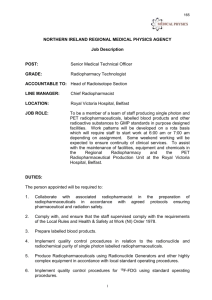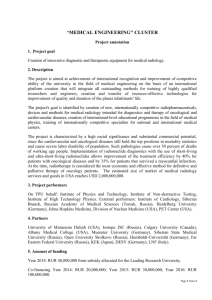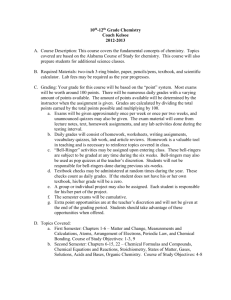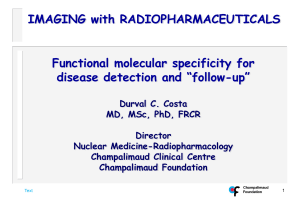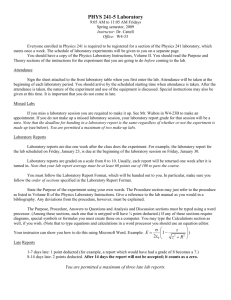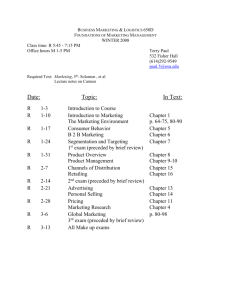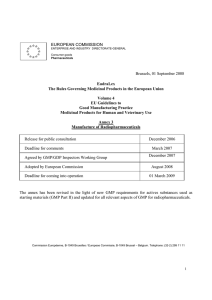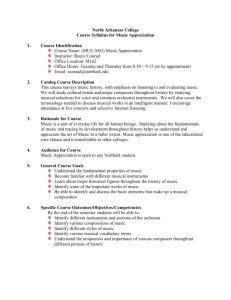Course Outline and Syllabus
advertisement
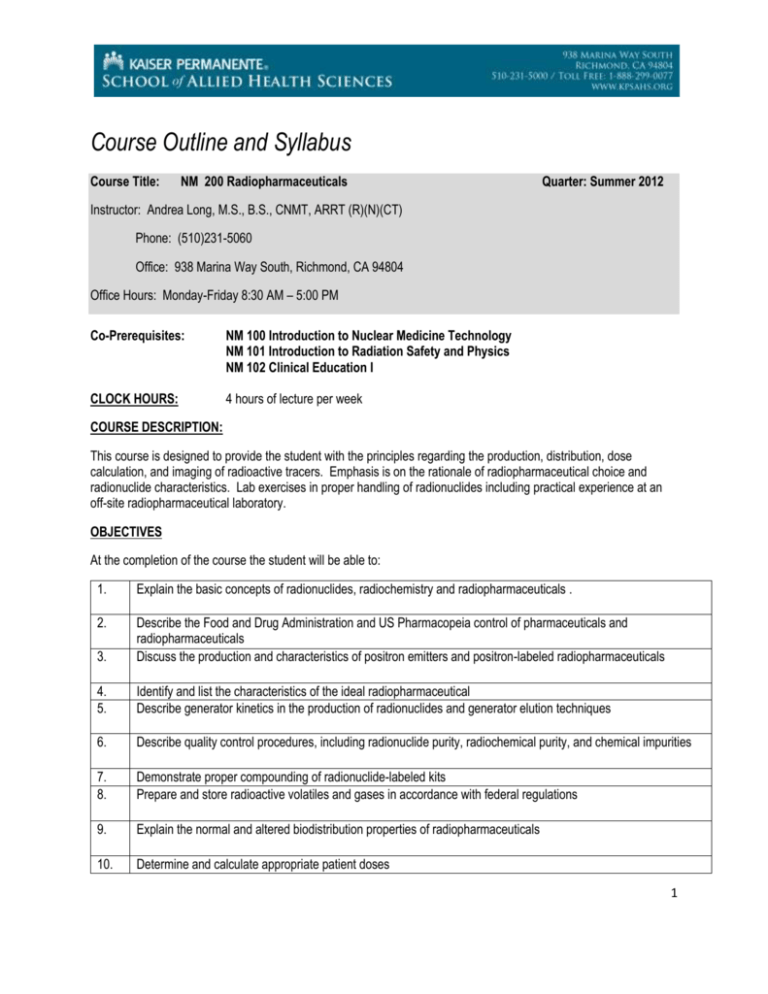
Course Outline and Syllabus Course Title: NM 200 Radiopharmaceuticals Quarter: Summer 2012 Instructor: Andrea Long, M.S., B.S., CNMT, ARRT (R)(N)(CT) Phone: (510)231-5060 Office: 938 Marina Way South, Richmond, CA 94804 Office Hours: Monday-Friday 8:30 AM – 5:00 PM Co-Prerequisites: NM 100 Introduction to Nuclear Medicine Technology NM 101 Introduction to Radiation Safety and Physics NM 102 Clinical Education I CLOCK HOURS: 4 hours of lecture per week COURSE DESCRIPTION: This course is designed to provide the student with the principles regarding the production, distribution, dose calculation, and imaging of radioactive tracers. Emphasis is on the rationale of radiopharmaceutical choice and radionuclide characteristics. Lab exercises in proper handling of radionuclides including practical experience at an off-site radiopharmaceutical laboratory. OBJECTIVES At the completion of the course the student will be able to: 1. Explain the basic concepts of radionuclides, radiochemistry and radiopharmaceuticals . 2. 3. Describe the Food and Drug Administration and US Pharmacopeia control of pharmaceuticals and radiopharmaceuticals Discuss the production and characteristics of positron emitters and positron-labeled radiopharmaceuticals 4. 5. Identify and list the characteristics of the ideal radiopharmaceutical Describe generator kinetics in the production of radionuclides and generator elution techniques 6. Describe quality control procedures, including radionuclide purity, radiochemical purity, and chemical impurities 7. 8. Demonstrate proper compounding of radionuclide-labeled kits Prepare and store radioactive volatiles and gases in accordance with federal regulations 9. Explain the normal and altered biodistribution properties of radiopharmaceuticals 10. Determine and calculate appropriate patient doses 1 11. 12. Describe the characteristics, proper use, and pharmacokinetics of radiopharmaceuticals, pharmaceuticals, and contrast media Analyze patient information to determine adverse reactions, interfering drugs, and administration contraindications of radiopharmaceuticals, pharmaceuticals, and contrast media Required Text Book Textbook Title: Fundamentals of Nuclear Pharmacy Author: Gopal B. Saha Pub/Ed/Date: Springer; 5th; 2003 Evaluation System The student’s course grade will be based on1,000 points with the following distribution: Laboratory Practical 150 points Laboratory Exercises 150 points Attendance & Participation 100 points Midterm Exam 250 points Final Exam 350 points Total Possible Points 1000 points KPSAHS Grading Policy Letter Grade A AB+ B BC+ C Percentage in Performance Grade Points 94-100 90-93 88-89 84-88 80-83 78-79 70-77 4.00 3.70 3.30 3.00 2.70 2.30 2.00 KPSAHS Academic Policies Department Grading Policy: The average grade of all practical exams must be 70% or greater to gain credit for this course. The final grade is based upon passing (separately) the written exams and practical exams. One grade is assigned for the entire course. A final grade of “F” will be assigned to students averaging less than 70% in either the written or practical exams. 2 Cheating and Plagiarism: Any form of cheating or plagiarism is serious and will not be tolerated. Academic achievement and proficiency in a subject matter cannot be achieved through cheating and/or plagiarism. Any student, who knowingly cheats, plagiarized and allows/aids another student in cheating or plagiarism will receive up to and/or including the following: A failing grade on a single assignment, test, and/or final course grade Suspension or dismissal from the program Honesty is a necessary trait in all health professionals. KPSAHS expects all students to practice honest and ethical behavior. Inability to fulfill this expectation will result in dismissal from the program. Attendance Policy and Exam Make-Up Policy: As stated in the Student Handbook, students are expected to attend all classes and labs. Attendance will be taken at the beginning of each class period. A sign-in sheet is used to record daily attendance. It is the student’s responsibility to sign in at each class (failure to do so will constitute an absence). Students are required to maintain 90% attendance in the course. Students who miss 10% will have their course grade lowered one full grade. Students who fail to attend 11% - 20% of the didactic time will have their course grade lowered two full grades. Any student who misses more than 20% will receive a failing grade for the course and may be subject to further disciplinary action. Extenuating circumstances should be brought to the attention of the instructor. * Two absences OR more than two tardies OR a combination of the two will result in a deduction of one letter grade. The student is responsible for contacting his/her instructor to determine whether make-up work must be completed. Furthermore, the student is responsible for gathering lecture notes from a student peer. Students who are absent on a test day must notify the instructor by phone prior to the exam in order to be allowed to take the exam at a later date. It is at the discretion of each individual instructor as to whether or not an exam can be made-up, regardless of the reason for the absence. The student will be expected to take the exam on the day of return and will have their test grade reduced by one. Failure to take any exam may result in an incomplete grade for the course. Only one exam may be taken late after an excused absence. If an exam is missed due to an unexcused absence, it may not be made up and a zero grade will be given for that exam. An unannounced quiz missed due to any type of absence may not be made up and a zero grade will be assigned. Assignments submitted one day late will receive 50% of the total earned grade. Assignments submitted after that will receive no grade. Students absent on the day an assignment is due shall be prepared to turn in their assignment on return. The final exam for this class will be given at the time and date specified and must be taken at that time. Classroom Management Use of all electronic devices is prohibited during class. Students found to be using such devices in class (or leaving lecture to respond to phone calls, texts, or pages) will be asked to leave the class and an absence will be documented for that day. Devices to record lectures will be allowed at the discretion of the instructor. There are no bathroom breaks during tests or quizzes. 3 Finals Week Attendance and Testing Policy 1. All final exams will be comprehensive in content. 2. Students should not schedule any activities which conflict with finals week activities: e.g. - plan out of town trips, schedule medical or dental appt., plan family activities, or other events which will prevent attendance during the entire finals week. 3. The scheduled time for exam(s) will be determined for each quarter. This schedule will be strictly adhered to for all written exams. Lab practical exams are scheduled during the quarter. 4. Mandatory attendance for all students is required. Failure to attend due to an unexcused absence for the scheduled exam will result in a zero and an “F” being assigned and averaged into the final grade for the course. 5. Students with an excused absence (documented medical emergency) will not be allowed to take the exam at a later date, but instead will be assigned a grade based upon all grades earned to date for that course. 6. There are no bathroom breaks allowed during the final exam. 4 Instructional Outline Week Topic Reading Assignment Week 1 Chemical Properties, Production of Radiopharmaceuticals, Kit Preparation Read Chapters 1 and 4 in the textbook. Week 2 Radionuclide Generators and kits Read Chapters 5 and 6 in the textbook Week 3 Q.C. of Radiopharmaceuticals; Lab Exercises for Calculation of Doses Read Chapter 8 in the textbook Week 4 Bio-routing, Preparation Techniques, Nuclear Pharmacy Function Read Chapters 7 and 9 Week 5 Comprehensive Review for Midterm; Lab exercises Radio-pharmacy Rotations begin week of January 28. Week 6 Midterm Examination Week 7 Federal Regulations, Record Keeping, and Computer Applications Read Chapter 11 in the textbook Week 8 Distribution of Various Radiopharmaceuticals and Pathology of the Organ Systems throughout the Body; Lab exercises Read Chapter 13 in the textbook Week 9 Distribution of Various Radiopharmaceuticals and Pathology of the Organ Systems throughout the Body (cont.) Week 10 Rationale and Selection of PET Radiopharmaceuticals; Lab exercises Week 11 Comprehensive Review for Final: Lab Practical Test Week 12 Final Examination Read Chapter 14 in the textbook 5
